WW1 & WW2 British / Australian Patt. 1907 Sword Bayonet 14th Light Horse Marked
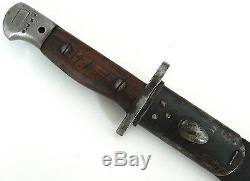
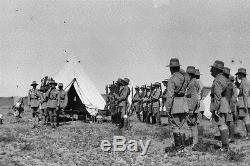
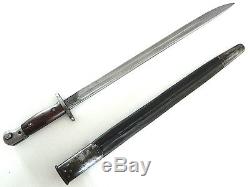
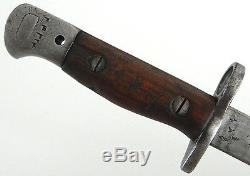
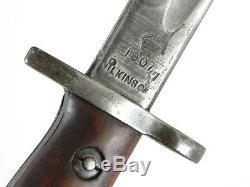
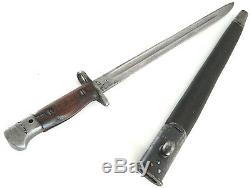
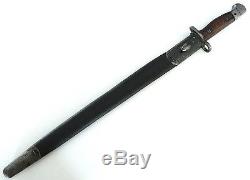
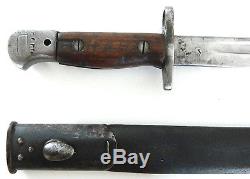

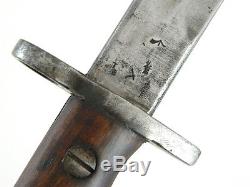
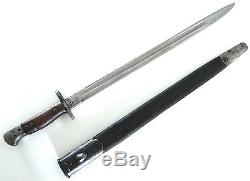
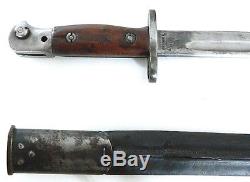

A FIRST WORLD WAR BRITISH LEE ENFIELD (PATTERN 1907) BAYONET MANUFACTURED. IN MAY 1917 AND FITTED WITH ITS ORIGINAL NUMBER 1 MARK II SCABBARD. STAMPED ON THE POMMEL WITH A UNIT MARK OF THE JODHPUR LANCERS AND ENGRAVED ON ONE GRIP WITH 14 L.
This Pattern 1907 Sword Bayonet is in excellent original condition and was manufactured in Britain during World War One in May 1917. By one of the most famous Pattern 1907 makers.And is fitted with its original First War manufactured version of the Number 1 Mark II Scabbard. What makes this bayonet particularly interesting are the unit marks.
On the pommel it is stamped with the unit mark of the Jodhpur Lancers , a unit of the Imperial Service Cavalry Brigade, and on one grip it is engraved 14 L. The commonly used abbreviation for the 14.
Australian Light Horse Regiment , a unit formed in Palestine in June 1918 from members of the Australian companies of the Imperial Camel Corps (ICC). On the other ricasso it also bears the'broad arrow' War Department acceptance mark and the' X' blade bending mark. It also has a unique WILKINSON inspectors mark of a crown over W and a couple of ROYAL SMALL ARMS FACTORY (RSAF) - ENFIELD inspectors stamps of a crown over X6 over E and a crown over S8 over E (see picture). The hilt with its large clearance hole and mahogany hardwood grips are excellent, as is the 17 inch blade which is in similar condition. The WILKINSON manufactured Number 1 Mark II scabbard, with its large teardrop shaped frog stud, is in excellent condition and is serviceable and tight and retains much of its original bluing.
With regard to Australian use, Ian D Skennerton in his outstanding reference work Australian Service Bayonets writes: The Pattern 1907 sword bayonet was actually not introduced until a year after the Mk III S. Many Australian troops were equipped with British manufactured bayonets and while most were subsequently stamped with Australian ownership marks not all were. At the outbreak of World War Two, Australia acquired a significant quantity of P1907 bayonets from British and Commonwealth stores as British troops were re-equipped with the Rifle No4 (and its spike bayonet) while the Australians retained the SMLE No1 MkIII. The twin unit marks are not inconsistent as.
Australian Light Horse Regiment , a unit formed in Palestine in June 1918 from members of the Australian companies of the Imperial Camel Corps (ICC) was almost certainly equipped from Imperial stores. The fact that the pommel is stamped with the unit mark of the Jodhpur Lancers , a unit of the Imperial Service Cavalry Brigade, are consistent with that being the case. This is reinforced by the engraving on one grip 14 L.Which was the commonly used abbreviation for the Light Horse. They almost never employed the official abbreviated title of A.
As they knew the were Australian. The 14th Light Horse Regiment was formed in Palestine in June 1918 from members of the Australian companies of the Imperial Camel Corps (ICC).
The ICC had been disbanded because camel-mounted troops, a valuable addition to the British forces in the deserts of Egypt and the Sinai, were not suitable for the conditions being encountered in Palestine. Although many former light horse troopers were to be found in the ranks of the ICC, large numbers had also been recruited from infantry battalions and so several months of training were needed before the 14th was fit to commence operations as a horse-mounted regiment.
The new regiment, along with another regiment of former cameleers - the 15th - and a regiment of French colonial cavalry, formed the 5th Light Horse Brigade, which became part of the Australian Mounted Division. The 5th Light Horse Brigade fought in only one major operation - the great offensive launched by the battle of Megiddo on 19 September 1918. On this morning British infantry opened a gap in the Turkish front to the north of Jaffa, allowing mounted forces to penetrate deep into their rear areas, severing roads, railways and communications links.
In ensuing days the Turkish front collapsed and as the Turks retreated into Syria they were harried by mounted troops, supported by aircraft, in close pursuit. In ten days from 19 September, the 5th Light Horse Brigade advanced over 650 kilometres.
The Brigade entered Damascus on 1 October 1918, and carried out mopping-up and garrison tasks in the vicinity of Damascus for most of October. The Brigade was moving forward to join the drive on Aleppo when Turkey surrendered on 30 October. While waiting to embark for home, the 14th Light Horse were called back to operational duty to quell the Egyptian revolt that erupted in March 1919; order was restored in little over a month. The men of the 14th Light Horse sailed for home, without their horses, which had either been shot or transferred to Indian cavalry units, on 24 July 1919. As a successor to the ICC, the 14th Light Horse inherited its battle honours. Single edged steel blade with round fullers, dated 5/17. A superb photograph is attached to this listing for reference. The mock burial of 1st Battalion, Imperial Camel Corps (ICC), when it became the 14th Australian Light Horse Regiment. The men are lined up solemnly before a coffin, a camel saddle draped with a union jack flag and their Pattern 1907 bayonets are visible attached to their webbing belts. (at guard): 23.0 mm.1 Mk II, steel and leather with a large teardrop shaped fixing stud. From Australia, a first rate First World War British Manufactured Pattern 1907 Sword Bayonet from. This bayonet is a cracking example of the seminal WW1 and WW2 British bayonet that was used by British and Commonwealth forces from 1907 until the late 1950s and beyond.
Of particular interest is the engraved grip indicating that it saw service with the 14th Australian Light Horse Regiment. The item "WW1 & WW2 British / Australian Patt. 1907 Sword Bayonet 14th Light Horse Marked" is in sale since Thursday, June 23, 2016. This item is in the category "Collectables\Militaria\1914 - 1918 (WWI)". The seller is "anzacblade" and is located in Griffith, ACT.This item can be shipped worldwide.
- Authenticity: Original
- Country: Britain / Australia
- Campaign: World War I
- Product Type: Bayonet
- Era: 1900s

